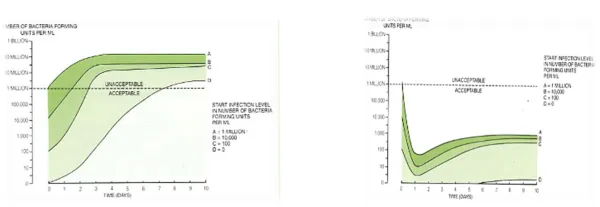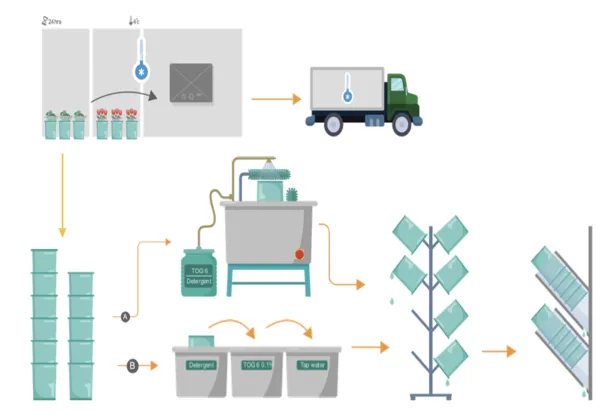In these unusual times when a microscopic virus has brought the world to its knees, we’ve had to go back to the basics we were told as children: Wash your hands, and sing Happy Birthday twice for good measure. Kill those germs!
When preparing cut flowers for shipping, hygiene is just as crucial. If left to luck, bacteria and fungi can cause serious damage to flowers pre and post harvest. They slow or block water uptake, hinder opening, and end with prematurely yellowing and wilting of flowers and leaves. Growers invest significantly in multiple solutions for the bucket water, dipping, and spraying, but often don’t go down to the most elementary level: the sanitation of facilities, buckets, and containers themselves. Regardless of the method used to ensure water stays clean while the flowers are in it, it’s better to keep harmful microorganisms from even appearing in the first place.

Effects of biocide treatment on the level of bacteria in vase solution. Credit: The Department of Postharvest Science of Fresh Produce, The Volcani Research Center, Israel.
At Gadot Agro in Israel, they have created their own lines of the T.O.G and LongLIfe post harvest treatments, for a range of solutions used by growers in geographic areas as diverse as Kenya, Colombia, and China, and they are happy to answer any specific questions or tackle any unprecedented problem you may be experiencing together with scientists and agronomists.
But right now, they’d like to share with you exactly what your grandma would say (if you bothered to ask her) before you even bring the flowers in for processing. Using T.O.G 6, a highly stabilized chlorine solution, combined with plain detergent to scrub the buckets well, will already make a difference and spare you future headaches.
The first alternative is to use an automated rotating brush bucket washer to scrape out the accumulated organic material with T.O.G 6 solution at 0.1% and detergent, then rinse out with clean water.
The second alternative is to submerge the buckets in detergent to remove the organic deposits manually, then apply T.O.G 6 at 0.1%, then rinse out with clean water. In both cases, buckets should then be hung out top down at a 30 degree angle to dry completely, before being stacked.

Sanitation with T.O.G 6 by Gadot Agro
This is the first step of many in the methodically planned protocols developed for each flower species, variety, season, climatic conditions, water quality, storage temperature, and other parameters that may affect the process, covering the entire chain from farm to vase. At every stage where flowers come into contact with any container at the farm, unpacker, wholesaler, supermarket, florist, or any other point of sale, all the way to the home, the company has just the right product in their specialized T.O.G and LongLife lines. Remember: Make sure there is no external source of contamination in your containers. Proper sanitation is the key.
For more information: Gadot Agro
Gadot Agro
[email protected]
www.gadotagro.com
